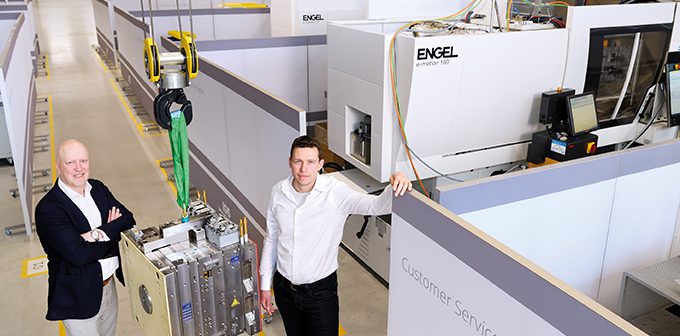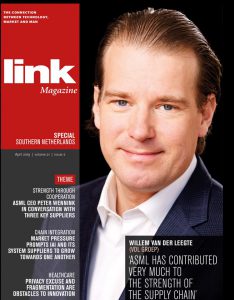IGS GeboJagema in Eindhoven produces high-tech injection moulds for drug delivery and in vitro diagnostics devices and for ophthalmic products (glasses and contact lenses). Its focus is on the healthcare market because high quality and a long product life cycle are the norm there. In order to comply with those requirements, the company works with accurate machines in automated production, uses a model-based method for design, manufacturing and inspection, and validates customers’ production processes.
Moving towards model-based mould making
The development of a new drug can cost a billion dollars or more, explains Hans Arts, sales director at IGS GeboJagema. ‘It takes seven to ten years to meet the stringent requirements of regulatory bodies like the FDA. So a drug needs to be on the market for the next 15-20 years in order to recoup those development costs. And all that time, moulds need to be manufactured and maintained to produce the plastic devices used to administer the drugs; for example, insulin pens or inhalers for asthma patients.’ In addition, those medical products are subject to rigorous standards for quality and safety in production and documentation.
‘Thanks to model-based manufacturing, the programmers do not need to program the same thing time and again’
With its highly automated production of high-tech moulds, IGS GeboJagema (with approximately 100 employees and 33 million euros in turnover in 2018) is a trend-setter in this challenging market. The product tolerances are one hundredth of a millimetre (10 µm) or less, says CTO Rob van den Brand. ‘That is extremely accurate for plastic. In addition, the visual quality has to be very high. In medical products, even the smallest film residue as a result of a die that does not close perfectly results in rejection. For example, in an inhaler there may be absolutely no film residues that can rub off. Moreover, we are often talking about multi-cavity moulds, which make 8, 16 or even 32 products at a time. They need to match exactly within a very narrow range.’
Model-based
This high quality is based on the automation of the entire product creation process, explains Arts. ‘We have been paperless since 2015. The operator calls up the current drawings on the screen. Previously, when using paper drawings, changes were sometimes missed. By going digital, we are also saying goodbye to those 2D drawings. From now on, when designing in CAD we will be working only with 3D models.’ In model-based design, everything is in the 3D file, including the information about surface finish and required tolerances. This generates time savings and quality improvements because information is no longer lost when converting 3D to 2D. The next step is to automate the programming as much as possible for production – CAM, which in turn allows for time savings and consistency in the programs. ‘Thanks to model-based manufacturing, the programmers do not need to program the same thing time and again; instead, as process engineers they can put more time into technology development, for example for new means of production or more efficient operations. Finally, we are moving towards model-based inspection. Based on the 3D geometry of a product, the measuring program is generated automatically, including the correct tolerances.’
Validation
With this integrated model-based approach, IGS has organised the product creation process efficiently. But the proof of the pudding is in the eating. For this reason, IGS validates new moulds, explains Rob van den Brand. ‘For each customer, we demonstrate that the ‘first out of tool’ products meet the requirements. For some customers we go further, for example by conducting an operational qualification study, which involves carrying out long production runs on injection moulding machines in our factory, performing all kinds of measurements on the products and providing the required documentation. The final step is the performance qualification, which always has to take place within the customer’s production environment. We can also take care of that if required: setting up the complete production process and performing all the tests. After that, the customer only has to press start.’
More and more customers, OEMs that manufacture their own products or their system suppliers, are opting to outsource as much as possible to IGS, Arts adds. ‘They take the view that their machines are there for production, not validation – after all, it represents lost production and costs them money. So we get to do the validation in house and when customers buy a new machine for a new product, for example, they give it to us first. To perform the validation we use the process optimisation methodology Pro-Op, developed by Cambridge University ten years ago, which we have developed further into our ‘scientific moulding’ concept.’
Five-axis milling
However well the process is organised, the machines have to deliver. IGS has for many years been using three-axis high-speed milling machines built by the Japanese firm Makino to produce high-quality moulds from hardened steel. The next step is five-axis machines, which have more degrees of freedom and can therefore make even more complex and accurate moulds. Two years ago, IGS entrusted that task to Makino, says Van den Brand. ‘They installed their new five-axis high-speed milling machine in our factory, the first in Europe. Together we worked for six months to bring the machine up to the desired level, and then another six months to incorporate production on that machine into an automated process. The effort has proved worthwhile – we have now added three more five-axis machines.’ Arts adds: ‘With an accuracy of two micrometres, ‘regular’ milling is difficult enough. In hardened steel with only air cooling – because water cooling causes contamination – and automated, too, it is almost impossible. Nevertheless, we succeeded. Our process engineers have developed an inspection protocol for the complete testing of all aspects of this machine. Makino, which, as a Japanese company is highly quality driven, has accepted it as the standard inspection protocol for their machine. We are proud of that.’
Investment
On the road towards Industry 4.0, IGS GeboJagema has been investing heavily for many years, particularly in new machines. Last autumn, the company also opened a new Customer Service Centre. This is where they validate the injection moulding machines, explains Arts. ‘We will be adding new machines, because we continue to track developments in injection moulding. New investments are also planned in precise finishing processes, such as hard turning, and in measuring machines. And we have also launched a study into the possibilities of 3D printing – for the third or fourth time. Using 3D-printing, followed by post-processing, we aim to make even more complex mould components and optimise internal cooling by printing cooling channels that follow the shape of the product. We are early adopters but we will only start production with 3D-printing if three conditions are met: we can print materials such as tool steel, printing yields a homogeneous result and the accuracy is high enough.’
Display
Accuracy always remains an issue for moulds, also in the non-medical market. That market represented a modest 7% of IGS GeboJagema’s turnover in 2018, but it is useful in continuing to challenge the process engineers. A recent example is a head-up display for inside a car that has to have a form accuracy of three micrometres over the entire surface. ‘The display needs to have the exact same curvature as the windscreen, which is different in each type of car, so we will need a lot of moulds. We have been wrestling with the task of making the first mould for one of these head-up displays for a while and last month we succeeded.’ Another appealing display of IGS GeboJagema’s competences.







